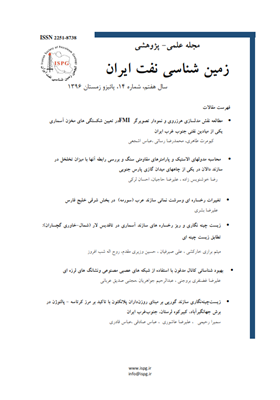محاسبه مدول¬های الاستیک و پارامتر¬های مقاومتی سنگ و بررسی رابطه آنها با میزان تخلخل در سازند دالان در یکی از چاه¬های میدان گازی پارس جنوبی
محورهای موضوعی : شاخه های دیگر علوم زمین در ارتباط با زمین شناسی نفترضا خوشنویس زاده 1 * , علیرضا حاجیان 2 , احسان لرکی 3
1 - دانشگاه شهید چمران
2 - دانشگاه ازاد نجف آباد
3 - دانشگاه ازاد واحد تهران
کلید واژه: مدول¬, های الاستیک, پارامترهای مقاومتی سنگ, ابزار DSI, سازند دالان,
چکیده مقاله :
پارامترهای الاستیک سنگ را می توان شامل مدول یانگ، نسبت پوآسون، مدول بالک و مدول برشی دانست. مدول یانگ سنگ همراه میزان مقاومت تکمحوری، دو پارامتر کلیدی در تعریف سنگ بکر هستند. مدول های الاستیک معرف میزان صلبیت سنگ بوده و بهعنوان شیب نمودار تنش- کرنش شناخته میشود. این پارامترها که نشاندهنده میزان مقاومت سنگ در برابر شکست هستند، از پارامترهای مهم برای تحلیل پایداری دیواره چاه به شمار میروند. با توجه به در دسترس نبودن و گران بودن داده های مغزه، و همچنین توجه به این مسئله که داده های حاصل از مغزه بهصورت پیوسته نبوده و در تمام نقاط چاه در دسترس نیستند، استفاده از لاگ DSI برای محاسبه مدول های الاستیک یکی از بهترین روشها برای محاسبه این پارامترها است. همچنین با استفاده از این لاگ می توان مدول های الاستیک را بهطور پیوسته در چاه، موردمطالعه قرارداد.در این مطالعه پارامترهای الاستیک دینامیک با استفاده از نمودار چاه پیمایی DSI، و نمودار چگالی برای سازند دالان محاسبه شد. با توجه به اینکه پارامترهای محاسبهشده با استفاده از سرعت امواج صوتی از نوع پارامترهای دینامیکی هستند، لذا این پارامترها با استفاده از روابط تجربی مناسب به مدول های استاتیک تبدیل شدند. پارامترهای مقاومت سنگ با استفاده از روابط تجربی که به طور متداول در صنعت نفت برای تعیین پارامترهای مقاومت سنگ استفاده می شوند، محاسبه شدند. این پارامترهای با توجه به مدول های الاستیک استاتیک و همچنین مقادیر تخلخل و حجم شیل محاسبه شد. مقایسه مقادیر مدول های الاستیک و پارامترهای مقاومتی سنگ با میزان تخلخل نشان داد که میزان تخلخل با مدول های الاستیک و پارامترهای مقاومتی سنگ رابطه عکس دارد، بهطوریکه با افزایش تخلخل میزان مدول های الاستیک و پارامترهای مقاومتی سنگ کاهشیافته است.
The elastic parameters of the rock include the Young modulus, the Poisson ratio, the bulk modulus and the shear modulus. Young modulus with the unconfined compressive strength of rock, are two key parameters in the definition of intact rock. Elastic modulus represents the amount of rock rigidity and is known as the stress-strain chart slope. These parameters represent of rock strength to failure, are important parameters for the stability analysis of wellbore stability. According to the unavailability and cost of core data, and also attended to this fact that the data from the core are not continuous and not available at all points in the well, the uses of DSI logs is one of the best methods for calculating elastic modules. Using these logs, you can also study elastic moduli continuously in a well. In this study, elastic dynamic parameters were calculated using the DSI and density logs for the Dalan Formation. Attention to the fact that the calculated parameters using the velocity of the sound waves are of the type of dynamic parameters, these parameters were have converted to the static modules using appropriate empirical relationships. The rock strength Parameters were calculated using the experimental relationships commonly used in the oil industry to determine rock strength parameters. These parameters were calculated according to static elastic modulus as well as porosity and shale volume. Comparing the values of elastic modulus and rock strength parameters with porosity showed that porosity with elastic modulus and rock strength parameters has an inverse relationship, so that with increases the porosity, the elastic modulus and rock strength parameters have been reduced.

